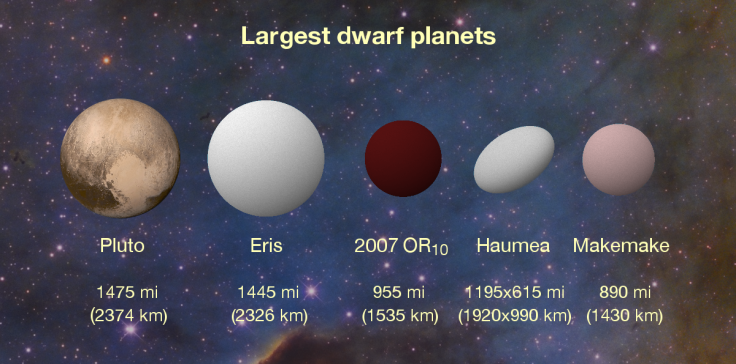Meet 2007 OR10, The Largest Dwarf Planet In Our Solar System Without A Name

The object known as 2007 OR10, despite being the third-largest dwarf planet in our solar system, has yet to be named. That could all change after data from the Kepler space telescope revealed new details about the distant world.
NASA revealed Wednesday new details of 2007 OR10 — discovered by astronomers Meg Schwamb, Mike Brown and David Rabinowitz in 2007 — using data collected by the Kepler space telescope and the ground-based Herschel Space Observatory in the Canary Islands. Based on the new information, 2007 OR10 has a diameter of 955 miles. That puts the dwarf planet ahead of Haumea and Makemake in size. Only Pluto (1,475 miles in diameter) and Eris (1,445 miles in diameter) are larger. The research was published in the Astrophysical Journal.
The Kepler data revealed that 2007 OR10, whose orbit extends beyond Pluto, has an incredibly slow rotation, taking 45 hours to complete one spin. By understanding the dwarf planet's rotation, researchers could gain insights into 2007 OR10's possible composition. "Our revised larger size for 2007 OR10 makes it increasingly likely the planet is covered in volatile ices of methane, carbon monoxide and nitrogen, which would be easily lost to space by a smaller object," András Pál, from the Konkoly Observatory in Budapest, said in a statement. The dwarf planet appears to have a dark, red surface.
Eris, discovered in 2005, was responsible for the new dwarf planet classification. Here was an object that appeared to be larger than Pluto in its astronomical neighborhood. Because of the discovery of Eris, the International Astronomical Union created an official definition for a planet. Pluto did not make the cut and is now identified as a dwarf planet. Similar objects, such as Haumea and Makemake, discovered around the same time as Eris were also classified as dwarf planets. Ceres was discovered centuries before any of these objects due to its location in the asteroid belt between Mars and Jupiter, but was first classified as an asteroid.
Meanwhile, while Pluto may have been demoted, there's evidence of a previously unknown ninth planet. Unfortunately, confirming these observations by Brown and astronomer Konstantin Batygin will take some time, but the astronomers are working to get time with some ground-based telescopes to possibly confirm the discovery of Planet 9.
© Copyright IBTimes 2025. All rights reserved.





















